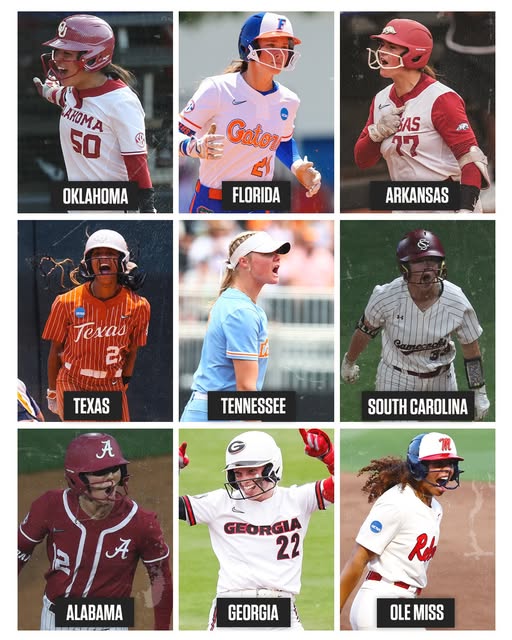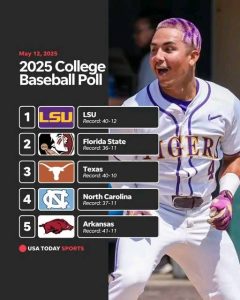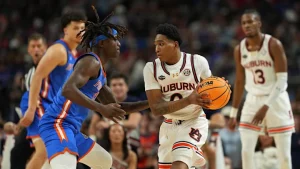
The SEC Ties the Record for Most Teams Advancing to the Super Regional: A Testament to Dominance in College Baseball
The Southeastern Conference (SEC), long regarded as a powerhouse in collegiate athletics, has once again proven its supremacy—this time on the baseball diamond. In the 2025 NCAA Baseball Tournament, the SEC tied the all-time record for the most teams advancing to the Super Regionals, an achievement that underscores the conference’s depth, talent, and relentless competitive drive. With eight teams making it through to this pivotal stage of the postseason, the SEC matches a mark that reflects not only the quality of individual programs but also the strength of the league as a whole.
College baseball has always had its traditional titans, and the SEC has regularly stood tall among them. Schools such as LSU, Florida, Vanderbilt, Arkansas, and Mississippi State have not only made frequent appearances in the College World Series (CWS) but have also captured national titles. The SEC’s latest milestone of sending eight teams to the Super Regional reinforces its dominance in the sport. It’s a testament to the recruiting pipelines, coaching acumen, and investment in facilities and development that schools in this conference have committed to over the years.
The Super Regional round is a crucial step on the road to Omaha, the ultimate goal for any Division I baseball team. To get there, teams must first survive the double-elimination Regional round, often against top competition from other major conferences and strong mid-major programs. That eight SEC teams were able to navigate their way through this gauntlet is both impressive and telling.
This year’s Super Regional qualifiers from the SEC include perennial powerhouses and a few programs that have grown in recent seasons to become legitimate contenders. The high number of teams advancing is not only a reflection of individual game-day performances but also a broader indication of how competitive and well-prepared SEC teams are throughout the season.
One of the most significant factors contributing to the SEC’s success is the level of competition within the conference itself. Every weekend during the regular season, SEC teams face off against opponents that could easily be ranked in the national top 25. Playing in such an intense environment sharpens players’ skills, toughens team resolve, and prepares them for the high stakes and pressure of postseason play.
Additionally, SEC teams typically boast some of the highest-ranked recruiting classes in the nation. Many players are drafted by Major League Baseball teams but choose to develop their game in the SEC for a few years before going pro. This influx of elite talent keeps the quality of play exceptionally high.
The SEC’s coaching staffs are among the best in the nation. Names like Tony Vitello (Tennessee), Jay Johnson (LSU), Kevin O’Sullivan (Florida), and Tim Corbin (Vanderbilt) have built powerhouse programs and are considered elite minds in the sport. Their ability to develop talent, manage high-pressure situations, and build winning cultures is a key reason for the consistent postseason success of SEC teams.
Moreover, the conference’s financial commitment to baseball is unmatched. From state-of-the-art stadiums to top-tier strength and conditioning programs, SEC schools invest heavily in their baseball programs. This commitment translates into better-prepared players and teams capable of withstanding the rigors of a deep postseason run.
What makes this record-tying feat even more impressive is the variety of programs represented. It’s not just the “usual suspects” like LSU, Florida, and Vanderbilt making the Super Regionals. Teams like Kentucky and South Carolina have emerged as serious threats, showing that the depth of the SEC extends beyond the traditional blue bloods. This kind of parity within the conference means that on any given weekend, any team can beat another—an environment that breeds excellence.
The SEC’s dominance has implications far beyond the conference itself. For one, it raises the overall profile of college baseball, drawing more fans, media attention, and investment into the sport. With eight of the sixteen Super Regional spots filled by SEC teams, the odds of an SEC school winning the national championship are extremely high. This level of dominance also puts pressure on other conferences to improve, invest more in their baseball programs, and find new ways to compete.
Furthermore, it impacts the NCAA Tournament selection process. As the SEC continues to show it deserves multiple bids, it sometimes results in fewer opportunities for teams from smaller conferences, sparking debates about equity and balance in college baseball.
With half of the Super Regional field composed of SEC teams, it’s highly likely that several of them will advance to the College World Series in Omaha. The question isn’t whether the SEC will be represented in Omaha—it’s how many of its teams will make the trip and whether one will emerge as national champion. Historically, when multiple SEC teams make it to the CWS, the odds favor the conference coming home with the trophy.
However, the internal competition will be fierce. SEC teams often end up facing one another in Omaha, turning what is usually a national championship tournament into what feels like an SEC Tournament Part II. While that may spark criticism from some corners of the college baseball world, it’s also a reflection of the reality: right now, the SEC is simply the best.





